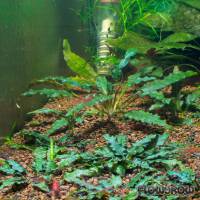



The name Cryptocoryne palawanensis is probably not very familiar, but this plant from the Philippines has been known for many years, including as an aquarium plant. It has long been mistaken for the species Cryptocoryne pygmaea Merrill (1919), the Dwarf water trumpet, which is also native to the Philippines. C. pygmaea occurs in western Mindanao and was initially only known in Europe from herbarium specimens. Then, in the 1970s, plants imported from the Philippines were identified as C. pygmaea. Later, locations of this plant were found on the islands of Busuanga and Palawan (see e.g. Bastmeijer and Morco 20001).
More recent investigations have shown that the plant from Busuanga and Palawan is clearly different from the actual C. pygmaea from western Mindanao. As a result, Bastmeijer, Jacobsen and Naive described it as a new species, C. palawanensis, in 2022.
Although the Palawan water trumpet has been occasionally sold under the name C. pygmaea for many years and is a fairly easy aquarium plant, it is apparently rarely kept in aquaria. The true C. pygmaea does not appear to be in aquarium culture at all. Confusingly, a few years ago a Cryptocoryne x willisii form came onto the market under the name "Cryptocoryne pigmea", but this plant has nothing to do with either the true C. pygmaea or C. palawanensis.
In the wild, Cryptocoryne palawanensis occurs in rivers and streams that often have hard water, both emersed on the banks and submerged in deeper water. Both in the natural habitat and in cultivation, the plants are quite small in the emersed form (approx. 5-8 cm high). In the submerged form they grow considerably larger, up to about 25 cm. The emersed leaves have a lanceolate blade shape, while the submerged leaves develop linear leaf blades with wavy edges and brown-green tones. Overall, submersed Cryptocoryne palawanensis is reminiscent of plants from the Cryptocoryne wendtii or C. beckettii species group from Sri Lanka. Like most Cryptocorynes, the plant forms underground runners. The species is somewhat variable, there are various forms that differ from each other in the appearance of leaves and inflorescences as well as in size when cultivated under the same conditions.
For further information, see "Culture" and "Design".
Medium lighting and a nutrient-rich substrate are recommended. Cryptocoryne palawanensis also grows in medium-hard water. Like most Cryptocorynes, it reproduces by underground runners.
For further information, see "Design".
The Palawan water trumpet, a quite rare species from the Philippines, can be used in a similar way to the Sri Lankan Cryptocorynes from the wendtii / beckettii group. It works well as a group in the midground.
<a href="https://www.flowgrow.de/db/aquaticplants/cryptocoryne-palawanensis" target="_blank"><img alt="Cryptocoryne palawanensis" title="Cryptocoryne palawanensis" src="https://www.flowgrow.de/db/widget/aquaticplants/cryptocoryne-palawanensis" /></a>
[url=https://www.flowgrow.de/db/aquaticplants/cryptocoryne-palawanensis][img]https://www.flowgrow.de/db/widget/aquaticplants/cryptocoryne-palawanensis[/img][/url]
[widget=aquaticplants/cryptocoryne-palawanensis]Cryptocoryne palawanensis[/widget]